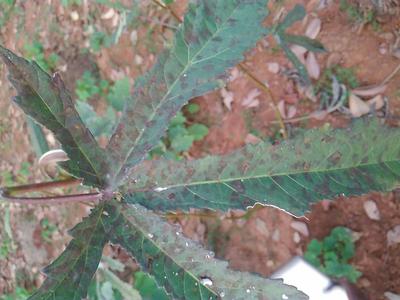Cercospora Leaf Spot of Okra
Cercospora malayensis
Fungus
In a Nutshell
- Brown irregular spots on the lower side of the leaves.
- Drying and wilting of leaves.
- Occurrence of defoliation.
Can also be found in
Symptoms
Initially, brown irregular spots appear on the lower side of the leaves. The older leaves, which are closer to the ground are mostly affected by the disease. The leaves become dry and brown as the disease progresses and might also curl and eventually drop. Under severe infestation, the plant might defoliate completely. Initially, the disease symptoms are obvious on the lower surface of the leaves as indistinct spots in the form of olivaceous specks. Later on, light brown to grey mouldy growth of the fungus covers the entire lower surface. In severe cases, necrotic spots can also be seen on the upper surface of the leaves. Infected leaves ultimately dry and defoliate. The disease progresses upwards from lower leaves and infects stem and fruits and produces similar symptoms. Symptoms might be confused with P. abelmoschi, which causes sooty black angular spots.
Recommendations

Organic Control
To this day, we are not aware of any biological control method available against this disease. If you know of any successful method to reduce the incidence or the gravity of the symptoms, please contact us.

Chemical Control
Always consider an integrated approach with preventive measures and biological treatments, if available. Spray fungicide on the lower side of leaves in the afternoon. Use protective fungicides as Copper oxychloride @ 0.3%, mancozeb @ 0.25% or zineb @ 0.2% a month after sowing and repeat this procedure at fortnightly intervals, depending on severity.
What caused it?
The leaf spots are caused by the fungus Cercospora malayensis and Cercospora abelmoschi. It survives and overwinters on infected plant debris in the soil and thus infects roots and lower leaves of the okra plants. The spores are spread secondarily via wind, rain, irrigation and mechanical tools. Leaf spots are very common during humid season, as the fungi favour warm and wet weather. Rainfall and high humidity favour infection, disease development and sporulation of the pathogens on the leaves.
Preventive Measures
- Only use certified seed material and plant your crops with enough spacing, so that leaves can air dry.
- Monitor your field regularly and remove infected leaves properly (burning them is also an option).
- Good weed managment is advised.
- Avoid plant stress with adequate watering and fertilization.
- Irrigate in the morning rather than in the evening, and avoid overhead irrigation and poorly drained soils.
- Consider crop rotation with non-host crops.



